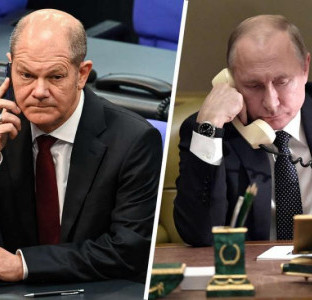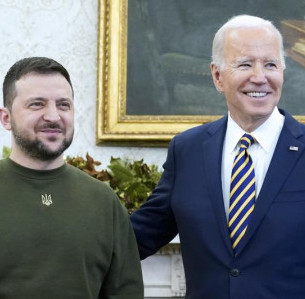Israel has very real reasons to fear Russia’s S-300 shipment to Syria if Damascus actually ends up independently wielding this defensive system to safeguard its airspace every time that it’s threatened, though that might be exactly why Tel Aviv and its American ally might wage an overwhelming preemptive strike to prevent that from happening.
It would be a strategic game-changer if the Syrian Arab Army (SAA) obtained the S-300s and used them to protect against any forthcoming Israeli and/or American strikes (whether carried out by warplanes or missiles), but it’s doubtful that either of them will peacefully forgo their freedom to militarily operate in the country with impunity. In and of itself, the SAA’s possession of this system would enable it to impose a “no-fly zone” over the country, to say nothing of extending this weapon’s reach into Israel’s de-facto borders and therefore hindering the Israeli Air Force’s ability to fly over its own territory. There’s no conceivable way that Israel would allow that to happen, nor that the US would accept its aircraft being unable to enter into the northeastern Kurdish-controlled part of the country that it’s occupying, which is why there’s either more to this announcement than is being made public or the world should brace for an impending joint strike by both of them against these systems.
About the first possibility, it should be noted that Shoigu didn’t say anything about Russia pulling out of its existing “deconfliction mechanisms” with Israel or the US, meaning that a “loophole” technically exists for both of them to avoid having their aircraft or missiles shot down so long as they coordinate their operations with Moscow like they were supposed to all along through these agreements. That, however, doesn’t remove the challenge posed to these “gentlemen’s deals” by the SAA, which could theoretically shoot down their aerial assets or missiles despite Russia “greenlighting” them beforehand. The very fact that the SAA might be able to independently wield the S-300s outside of Russian control terrifies Israel and the US and is enough of a strategic uncertainty that neither of them is likely to allow that state of affairs to ever enter into existence. The reasons for this are many, but the most important ones are as follows.
To begin with and to repeat what was mentioned earlier, Israel will not accept Syria having the military possibility to target aircraft over its own airspace, the same as the US won’t do the same when it comes to Damascus obtaining the means to shoot down its planes flying over the northeast of the country. This would suggest that Russia might place restrictions on the locations where Syria could deploy these systems in order to prevent them from targeting either of those parties’ aircraft over those areas, but since the S-300’s range is between 200-250km, they can easily cover those territories anyhow, thus making this a moot point. Furthermore, there doesn’t exist enough trust between Israel and the US on the one hand and Russia – let alone Syria, too – on the other for the first-mentioned pair to not be concerned about this even if it was the case.
Another point that needs to be mentioned is that Israel isn’t going to tolerate any so-called “safe zones” for the IRGC and Hezbollah in Syria, which is what Damascus would de-facto be creating if it was given control of its own S-300s. Russia must certainly be aware of Israel’s publicly proclaimed stance on this issue and would know that delivering the S-300s to Damascus could trigger Tel Aviv into destroying these assets if they ever targeted its aircraft, so this once again brings the analysis back to wondering whether Syria would really be gaining independent control over these systems like many in the public seem to think they would or if Russia would secretly still be in control of them. The latter scenario isn’t speculation either because presidential spokesman Peskov said that the S-300s are “not directed against third countries, they are meant to protect our own troops.”
This statement is relatively ambiguous because it seems to somewhat contradict what Shoigu said about Syria obtaining control over these systems, and it would be unprecedented for Russia to “outsource” the security of its personnel to Syria when it’s more than capable of protecting them on its own with the said systems. It could be, however, that Peskov is just adding “diplomatic sugar” to Shoigu’s announcement and “covering up” for Russia’s shipment of S-300s to the SAA by giving it a “publicly plausible” reason that doesn’t have any official “anti-Israeli” purpose. If that’s what’s happening, then it should still be expected that Israel will strike these units like it threatened to do earlier in the year when there was renewed talk about their transfer to the SAA, and it might even be joined by the US in doing so for the reasons mentioned earlier in this analysis.
Russia didn’t sacrifice as much as it already did just to get to this far of a point in the war and have the SAA possibly obliterated by an overwhelming swarm of Israeli and American missiles in response to its partner using the S-300s against either of their aircraft, nor will Moscow likely order its soldiers to function as “human shields”/“tripwires” for guaranteeing that Russia retaliates against their possible destruction. The stakes seem to have been raised in this game of geopolitical poker, though cooler heads will probably prevail in thwarting the worst-case scenario that was just described. Some way or another, Russia will probably ensure that it still retains a degree of control over the S-300s that it transfers to the SAA, possibly including the authority to temporarily prevent them from locking onto certain targets on a case-by-case basis following the approval of Israeli and American operations coordinated through the “deconfliction mechanism”.
Syria must certainly know that using the S-300s to attack Israeli aircraft over Israel or American ones over the Kurdish-controlled northeast that the Pentagon is occupying would most likely trigger a devastating response, so even in the event that it has full independent control over these weapons, it probably wouldn’t use them for those purposes. It would, however, protect its most important infrastructure and facilities from attacks by either of them, but therein lays the rub because neither Israel nor the US could be certain that those locations aren’t functioning as “safe zones” for the IRGC or Hezbollah, much less their speculative missile-making warehouses, so the “security dilemma” (to reference a well-known concept of International Relations theory) is still much too intense for them not to be “provoked” into a “preemptive”, or at the very least overwhelming retaliatory, strike.
In summary, Israel and the US have everything to fear from Syria gaining unrestricted control over the S-300s, but likewise, so too does Syria almost counterintuitively have something to fear from this too because of the likelihood that it could “push” both of them into launching a preemptive strike against it. Russia also – again, counterintuitively – shares the same fears as well because it probably doesn’t have the “political will” to risk World War III through the necessary brinksmanship of backing up the SAA if it shoots down Israeli and/or American jets and/or missiles, leave alone if it’s victimized by a devastating preemptive or retaliatory strike, which raises the question of why it’s transferring S-300s to it in the first place unless there’s much more to this agreement than meets the eye. Nothing is as it seems, that much is clear, but it’ll take the unfolding of forthcoming events for observers to get a better idea of what might really be going on.
DISCLAIMER: The author writes for this publication in a private capacity which is unrepresentative of anyone or any organization except for his own personal views. Nothing written by the author should ever be conflated with the editorial views or official positions of any other media outlet or institution.









